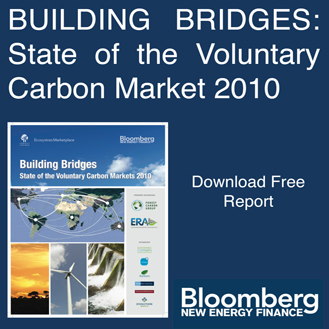U.S. the second biggest buyer of forests based voluntary carbon credits in 2009
-----------------
As we know, one of the few beneficial side effects of the Great Recession of 2009 was the decline in global greenhouse gas emissions as our consumer-centric economy sputtered. But that also sent the voluntary carbon markets into a tailspin, according to a new report released Tuesday by Bloomberg New Energy Finance and Ecosystem Marketplace.
Voluntary carbon markets, such as the Chicago Climate Exchange, allow companies to trade carbon credits, usually as part of corporate sustainability programs where they pledge to neutralize greenhouse gas emissions by buying offsets tied to forestry programs, the capture of methane gas from landfills, and other efforts. (Such markets should not be confused with mandatory, regulated markets such as the European Trading Scheme.)
The value of greenhouse gas emissions credits traded on the voluntary markets plunged 47 percent in 2009 to $387.4 million, while the volume of greenhouse gas emissions traded fell 26 percent to 93.7 millions of tons of carbon dioxide equivalent (MtCO2e).
"The economic recession had a marked impact on the number of companies offsetting greenhouse gas (GHG) emissions," wrote the report's authors, who compiled data provided by more than 200 carbon credit suppliers and the carbon exchanges. "In response to the global financial crisis, companies cut back on discretionary funding for corporate social responsibility initiatives, including offsetting emissions. At the same time, the prospects for new compliance demand remained uncertain."
Still, even in a recession the volume of greenhouse gas emissions traded in 2009 was 39 percent higher than in 2007.
Interestingly, the regulated carbon markets powered through the downturn, growing 7 percent with 8,625 MtCO2e traded at a value of $144 billion, according to the report.
The United States became the world's biggest supplier of voluntary carbon credits for the first time last year, followed by Latin America and Asia.
Methane-related projects accounted for 41 percent of offset credits while forestry programs were tied to 24 percent of credits and renewable energy to 17 percent.
"Survey respondents were highly positive about the prospects for the global voluntary markets and collectively believe transactions will increase to approximately 400 MtCO2e in 2012, 800 MtCO2e in 2015, and 1,200 MtCO2e in 2020," the report concluded. "Whether this growth will actually be achieved remains to be seen; it does demonstrate a strong sense of optimism for future activity in the voluntary marketplace."
The U.S. was the largest buyer of voluntary carbon credits last year, according to a new report released by Ecosystem Marketplace and Bloomberg New Energy Finance. However, total voluntary carbon transactions dropped by 26 percent, according to the report. The total value of traded credits declined 47 percent to $387 million in 2009 and the average price of an emission reduction was $6.5/tCO2e.
Although the economic downturn reduced offset purchasing for corporate social responsibility, the report notes significant growth in the pre-compliance segment of the voluntary markets.
The survey found a near doubling in the use of independent, third-party “registries,” which track ownership of offsets so that individual emission reductions are not counted twice. The survey identified 17 registries accounting for 51 percent of all voluntary offset transactions last year, while just 29 percent of transactions were listed with registries in 2008. The survey attributes the growth in registry uptake largely to the emergence of multiple registries spread across different regions.
The most popular project types were those that destroy methane – a greenhouse gas that traps more than 20 times as much heat as carbon dioxide. These projects stand a good chance of being grandfathered into a US compliance scheme, and they accounted for 41 percent of voluntary offset transactions in 2009. Forestry projects were next, at 24 percent, followed by renewable energy projects, at 17 percent. The US took the lead from Asia this year as the source of the vast majority of offset credits (56 percent),
followed by Latin America (16 percent) and Asia (12 percent).
|
---------------


